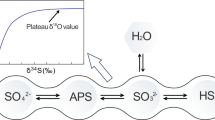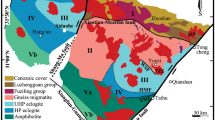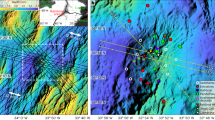Abstract
Whole-rock oxygen isotope data from a suite of mafic and ultramafic samples from the Onverwacht Group, the basal unit of the Archaean greenstone succession of the Barberton Mountain Land, South Africa, show a range of values from δ18O ≃ +3 to δ18O ≃ +14, a range which coincides with those of Phanerozoic ophiolites and oceanic crust. When the samples are arranged in an inferred ophiolitic pseudostratigraphy, from basal serpentinized ultramafic cumulates through altered mafic extrusives, they have an oxygen isotope distribution profile which is indistinguishable from that of Phanerozoic ophiolites. The distinctive isotopic profiles and secondary mineral assemblages in Phanerozoic ophiolites are caused by hydrothermal interaction between seawater (δ18O≃0) and oceanic crust (δ18O≃ +5.8). The existence of a similar isotopic and metamorphic profile in the Onverwacht Group argues strongly that these rocks were hydrothermally altered by an Archaean ocean whose isotopic composition was indistinguishable from modern sea water.
Similar content being viewed by others
Article PDF
References
Hamilton, P. J., 279, 298–300 (1979).
Jahn, B. M., Gruau, G. & Glikson, A. Y. Contr. Miner. Petrol. 80, 25–40 (1982).
Jahn, B. M. & Shih, C. Geochim. cosmochim. Acta 38, 611–627 (1974).
Van Niekirk, C. B. & Burger, A. J. Trans. geol. Soc. S. Afr. 72, 9–25 (1969).
Hurley, P. M., Nagy, B. & Pinson, W. H. Jr Earth planet. Sci. Lett. 14, 360 (1972).
De Wit, M. J. et al. Econ. Geol. 77, 1783–1802 (1982).
York, D. et al. Eos 62, 429 (1981).
Martinez, M. L. et al. Nature 307, 352–354 (1984).
Viljoen, M. J. & Viljoen, R. P. Spec. Pub. geol. Soc. S. Afr. 2, 9–151 (1969).
Tankard, A. J. et al. Crustal Evolution of Southern Africa (Springer, New York, 1982).
Viljoen, M. J. & Viljoen, R. P. in African Magmatism and Tectonics (eds Clifford, T. N. & Gass, I. G.) 27–49 (Oliver and Boyd, Edinburgh, 1970).
Williams, D. & Furnell, R. G. Precamb. Res. 9, 325–347 (1979).
De Wit, M. J. J. struct. Geol. 4, 117–136 (1982).
De Wit, M. J. Spec. Pub. geol. Soc. S. Afr. 9, 185–187 (1983).
De Wit, M. J., Fripp, R. E. P. & Stanistreet, I. G. Spec. Pub. geol. Soc. S. Afr. 9, 21–29 (1983).
De Wit, M. J. & Stern, C. R. 2nd int. Archaean Symp., Perth 85–87 (Geological Society of Australia, 1980).
Taylor, H. P. Jr & Epstein, S. Geol. Soc. Am. Bull. 73, 461–480 (1962).
Clayton, R. N. & Mayeda, T. K. Geochim. cosmochim. Acta 27, 43–52 (1963).
Coplen, T. B., Kendall, C. & Hopple, J. Nature 302, 236–238 (1983).
Gregory, R. T. & Taylor, H. P. Jr J. geophys. Res. 86(B4) 2737–2755 (1981).
Cocker, J. D., Griffin, B. J. & Muehlenbachs, K. Earth planet. Sci. Lett. 61, 112–122 (1976).
Stern, C. R., De Wit, M. J. & Lawrence, J. R. J. geophys. Res. 81, 4370–4380 (1976).
Hoffman, S. E. thesis, Oregon State Univ. College of Oceanography (1985).
Stakes, D. S. & O'Neil, J. R. Earth planet. Sci. Lett. 57, 285–304 (1982).
Taylor, H. P. Jr in Hydrothermal Processes at Seafloor Spreading Centers (eds Rona, P. A. et al.) 83–139 (Plenum, New York, 1983).
Muehlenbachs, K. & Clayton, R. N. Can. J. Earth Sci. 9, 471–478 (1972).
Beaty, D. W. thesis, California Institute of Technology (1980).
Beaty, D. W. & Taylor, H. P. Jr Econ. Geol. 77, 95–108 (1982).
Hein, J. R. & Yeh, H.-W. Init. Rep. DSDP 62, 749–758 (1981).
Perry, E. C. Jr & Tan, F. C. Geol. Soc. Amer. Bull. 83, 647–664 (1972).
Heinrichs, T. Precamb. Res. 24, 237–283 (1984).
Lowe, D. R. & Knauth, L. P. J. Geol. 85, 699–723 (1977).
Muehlenbachs, K. & Clayton, R. N. J. geophys. Res. 81, 4365–4369 (1976).
Abbott, D. H. & Hoffman, S. E. Tectonics 3, 439–448 (1984).
Taylor, H. P. Jr J. geol. Soc. Lond. 133, 509–558 (1977).
Beaty, D. W. & Taylor, H. P. Jr in Komatiites (ed Arndt, N. T. & Nisbet, E. G.), 267–280 (Alien & Unwin, London, 1982).
Author information
Authors and Affiliations
Rights and permissions
About this article
Cite this article
Hoffman, S., Wilson, M. & Stakes, D. Inferred oxygen isotope profile of Archaean oceanic crust, Onverwacht Group, South Africa. Nature 321, 55–58 (1986). https://doi.org/10.1038/321055a0
Received:
Accepted:
Published:
Issue date:
DOI: https://doi.org/10.1038/321055a0
This article is cited by
-
Typical oxygen isotope profile of altered oceanic crust recorded in continental intraplate basalts
Journal of Earth Science (2017)
-
The Silurian of Gotland (Sweden): facies interpretation based on stable isotopes in brachiopod shells
Geologische Rundschau (1996)



